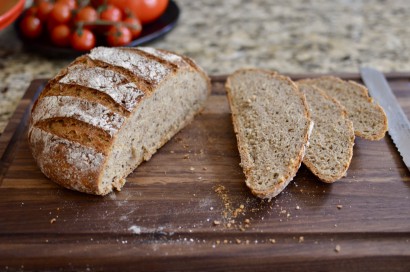No Reviews
You must be logged in to post a review.

This rustic rye bread is heavy and dense, with lots of chew. It requires no kneading, just time. Mix the ingredients together in a bowl, cover and walk away. After 18–20 hours, shape and bake. Super simple and the results are nothing short of spectacular.
In a large mixing bowl, combine flours, caraway seeds, vital wheat gluten (if using), sea salt, sugar, and yeast. Add water and buttermilk, stir until a shaggy mass forms and no traces of dry ingredients remain. Cover well with plastic and set aside at room temperature for 18–20 hours.
An hour before baking, preheat oven to 500ºF with a 6 or 8-quart covered Dutch oven placed on the center rack. Gently turn the bread dough out of the mixing bowl and onto a floured surface. Do not punch the dough down. Gather the edges of the dough and pull toward the center, pinching to seal them together, then turn the dough over so the pinched ends are on the bottom.
Use your hands to gently tuck and turn, forming a round loaf. Cover with inverted bowl and allow dough to rest for 30 minutes.
Just before baking, uncover dough and use a baker’s lame (see notes below) to make several score marks across the top. Remove preheated Dutch oven from oven and lower oven temperature to 450ºF. Carefully place dough into the hot Dutch oven (I like to do this with a parchment paper sling). Cover Dutch oven and place back on center rack. Bake for 50–60 minutes or until the internal bread temperature reaches 205-210ºF.
Notes:
• The cooking vessel I prefer to use is enameled cast iron, but a similarly-sized cast iron, pyrex, or ceramic vessel with a tight-fitting lid will also work.
• My rye flour of choice is 100% stone ground, but use any rye you have.
• Vital wheat gluten adds a little more “chew” to the bread, but if you don’t worry if you don’t have it—the bread will still be good.
• If you don’t have a baker’s lame to score the top of the dough, you can use a new razor blade or very sharp knife.
• No buttermilk? You can make a substitute by combining 1 teaspoon white vinegar or lemon juice to 1/4 cup (less 1 teaspoon) milk. Rest for 5 minutes or more before using. Alternately, you can purchase dry buttermilk powder that you mix with water (it’s shelf stable and a great item to keep with your baking supplies).
No Comments
Leave a Comment!
You must be logged in to post a comment.